In the vibrant tapestry of Indian culture, rituals and traditions hold a special place. One of the most significant rituals in Indian households is the daily pooja or prayer, where families come together to offer their reverence to the divine. To facilitate these sacred moments, the concept of a puja room design has evolved over the years.
In this comprehensive guide, we will delve into the enchanting world of Indian style pooja room designs. From the historical significance of pooja rooms to contemporary design ideas, we’ll cover it all to help you create a sacred space that resonates with your spirituality and aesthetics.
The practice of offering prayers and performing rituals has been an integral part of Indian culture for centuries. The concept of the Indian style pooja room designs, or puja room, has its roots in ancient Indian traditions. It is believed that the Vedas, ancient scriptures of Hinduism, mention the importance of creating a designated space for spiritual activities. Over time, this concept has evolved, taking on various forms and styles.
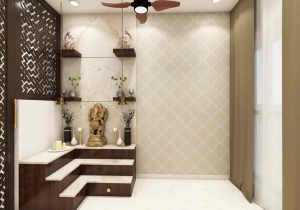
A puja room design is not merely a physical space; it is a sanctified corner of your home where you connect with the divine. It is a place where you seek solace, meditate, and offer your devotion. Designing a indian style pooja room is not just about aesthetics but also about creating an atmosphere that enhances your spiritual experience.
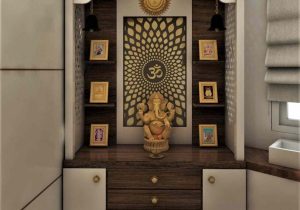
Choosing the right location for your Indian style pooja room designs is crucial.
Traditionally, people place it in the northeast or east direction of the house, believing that these directions are auspicious and help channel positive energy.
However, if space constraints don’t allow this, the north or northeast corners of other rooms can also work.
Indian style pooja rooms are characterised by specific design elements that add to their sanctity and beauty:
Vastu Shastra, the ancient Indian science of architecture, provides guidelines for creating a harmonious living space. When designing a pooja room, adhering to Vastu principles can enhance the spiritual energy of the room. Some Vastu tips for Indian style pooja room designs include:
Traditional Indian Style Pooja Room Designs
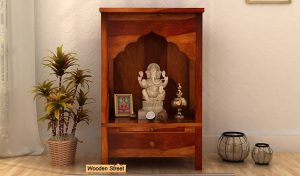
Wood is a quintessential material for traditional Indian pooja rooms. Wooden temples or mandirs come in various intricate designs, from simple to ornate. Teak, rosewood, and sheesham are popular choices for crafting these temples. The warm, natural tones of wood create a calming atmosphere in the room.
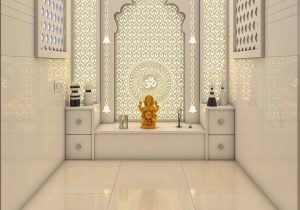
Marble is another traditional material used in the construction of pooja rooms. A marble mandir exudes elegance and grandeur. These temples often feature finely carved details and are available in various sizes to suit different spaces.
The South Indian style of pooja room design is known for its distinctive architecture. It typically includes a granite or stone altar with intricate carvings. The use of brass or copper accessories complements the design, creating a harmonious aesthetic.
In North India, you’ll find a diverse range of Indian style pooja room designs influenced by Mughal, Rajasthani, and other regional styles. These designs often incorporate vibrant colours, mirror work, and ornate patterns. The use of textiles like silk and brocade for decorating the temple adds a regal touch.
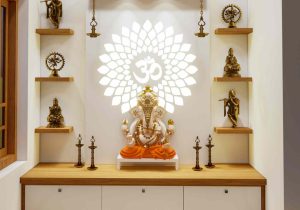
Many Indian families draw inspiration from famous temples when designing their pooja rooms. Miniature replicas of temples like the Golden Temple, Jagannath Temple, or Meenakshi Temple can be crafted as the centrepiece of the room, paying homage to these sacred places.
In the modern era, minimalism is gaining popularity. Minimalist pooja rooms are characterised by clean lines, neutral colours, and a clutter-free environment. Wall-mounted shelves or alcoves can be used to display idols and accessories, creating a simple yet elegant space.
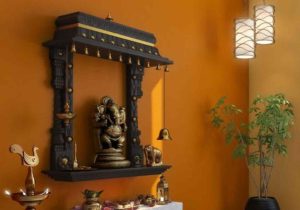
Wall-mounted mandirs are a space-saving solution for smaller homes or apartments. These compact temples can be installed on any wall and feature sleek designs that blend seamlessly with contemporary interiors.
Open concept pooja rooms break away from the traditional enclosed design. Instead, they are integrated into the living or dining area, allowing for a seamless transition between daily activities and spiritual practices. Glass partitions or screens can be used to define the space while maintaining a sense of openness.
For those who appreciate a blend of traditional and contemporary styles, fusion designs offer a unique solution. These designs incorporate traditional elements like wooden mandirs or idols into modern interiors, creating a harmonious juxtaposition.
With growing environmental awareness, eco-friendly pooja rooms are becoming popular. These designs use sustainable materials, energy-efficient lighting, and indoor plants to create a green and serene atmosphere.
Lighting plays a crucial role in setting the ambiance of a Indian style pooja room designs. Soft, warm lighting is preferred as it creates a peaceful atmosphere. Consider using LED lights with adjustable brightness to suit different rituals and occasions. Hanging lamps or pendant lights above the mandir can add a touch of elegance.
Proper ventilation is essential to maintain a fresh and positive energy flow within the pooja room. Ensure that the room has windows or a ventilation system to allow for the circulation of air. However, avoid placing the mandir directly under a window to prevent harsh sunlight from falling on the deities.
Fresh flowers are a common offering in Indian pooja rooms. You can incorporate floral decor by placing vases of flowers or garlands near the mandir. The natural fragrance of flowers enhances the spiritual experience.
Incorporate textiles like silk or velvet drapes in vibrant colours to add a touch of luxury to the pooja room. You can use these fabrics for curtains, cushion covers, or table runners, thereby adding texture and richness to the space.

Choose wall art or paintings with spiritual themes to adorn the walls of the pooja room. These artworks can evoke a sense of devotion and tranquility.
Hang small bells or wind chimes near the entrance of the pooja room. Believers attribute the gentle tinkling sound to inviting positive energy and warding off negativity.
A pooja room reflects your beliefs and practices. Personalise it by incorporating elements that resonate with your spirituality. You can include family heirlooms, special artifacts, or even create a dedicated space for meditation or yoga.
Modular pooja units are becoming increasingly popular due to their flexibility and ease of customisation. Pre-designed elements within these units can be arranged to fit your available space and preferences.
If you’re unsure about how to design your pooja room, consider consulting a professional interior designer who specialises in creating spiritual spaces. They can help you bring your vision to life while ensuring that it aligns with your beliefs and Vastu principles.
To maintain the sanctity of your pooja room, it’s essential to keep it clean and free from dust. Regularly wipe down the idols, shelves, and any accessories. Change the cloth or mat under the idols as needed.
Make it a habit to offer daily prayers and perform rituals in your pooja room. This not only keeps the space spiritually charged but also reinforces your connection with the divine.
Avoid cluttering the pooja room with unnecessary items. Keep it simple and organised to create a serene atmosphere that is conducive to meditation and prayer.
Creating a serene and sacred pooja space within the confines of your home is a contemporary trend that seamlessly blends spirituality with modern aesthetics. The concept of a modern pooja room transcends traditional norms, incorporating innovative mandir designs that elevate the spiritual experience. Many homeowners are opting to dedicate a separate room to their pooja space, allowing for a tranquil environment free from distractions.
The entrance to this sacred enclave is often adorned with a thoughtfully crafted wooden door, setting the tone for the sanctity within. The modern pooja room serves not only as a place of worship but also as a design focal point, with individuals exploring diverse mandir designs to infuse a sense of peace and harmony into their living spaces. This approach aligns with the desire for a harmonious home, where spirituality and design seamlessly coexist behind the welcoming embrace of a carefully chosen wooden door.
In the tapestry of Indian culture, the pooja room stands as a sacred space where spirituality, tradition, and design converge. Whether you opt for a traditional wooden mandir, a contemporary wall-mounted altar, or a fusion of styles, your pooja room should reflect your beliefs and a source of solace and inspiration.
By understanding the historical significance, adhering to Vastu principles, and incorporating the right design elements, you can create a pooja room that not only enhances the aesthetics of your home but also elevates your spiritual experience. So, embark on this journey of self-discovery and devotion as you design your very own Indian style pooja room designs, where faith and design harmoniously coexist.
Visit Bonito Designs for Personalised Full Home Interiors.